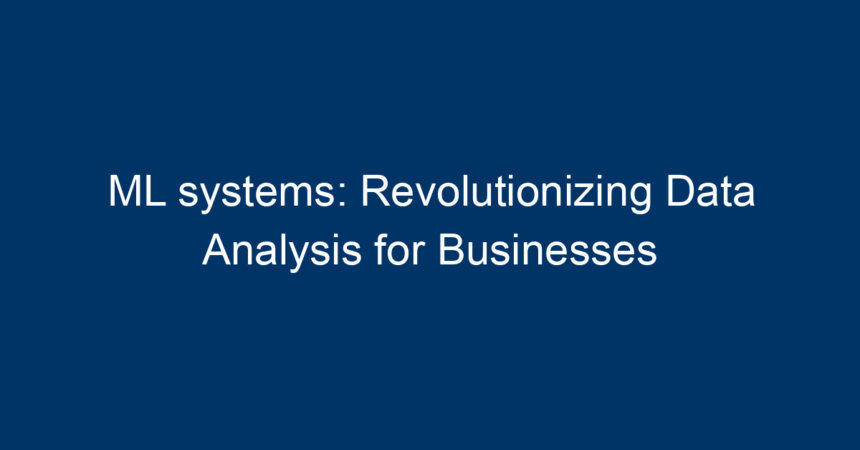In today’s data-driven world, businesses are inundated with vast amounts of information. The ability to analyze this data quickly and accurately has become imperative to maintaining a competitive edge. Enter Machine Learning (ML) systems: a groundbreaking innovation that is redefining how businesses approach data analysis. From predictive analytics to automated reporting, ML systems are transforming the landscape of business intelligence. This article explores the power of ML systems, their applications, and actionable insights on integrating them into your business strategy.
What Are ML Systems?
Machine Learning systems are algorithms and statistical models that enable computers to perform tasks without explicit instructions. Instead of relying solely on human input, these systems learn from data, identifying patterns and making predictions. This self-learning ability allows businesses to glean insights from their data more efficiently than traditional methods.
Types of ML Systems
ML systems can be broadly categorized into three types:
-
Supervised Learning:
- Involves using labeled data to train the model. The system learns from past data and applies that knowledge to predict outcomes for new, unseen data.
- Common applications include spam detection and customer churn prediction.
-
Unsupervised Learning:
- These systems learn from unlabeled data, identifying hidden patterns without any prior guidance.
- Applications include customer segmentation and anomaly detection.
- Reinforcement Learning:
- This type focuses on training agents to make a sequence of decisions. It learns by receiving feedback in the form of rewards or penalties, making it particularly effective in dynamic environments.
- Commonly used in robotics, game AI, and autonomous vehicles.
The Role of ML Systems in Data Analysis
Data analysis is crucial for informed decision-making. ML systems revolutionize this process by providing businesses with tools to handle complex datasets easily.
Enhancing Predictive Analytics
Predictive analytics powered by ML systems allows businesses to forecast trends and behaviors. For instance, by analyzing historical sales data, a retail company can predict which products are likely to perform well in the upcoming season. This capability not only helps in inventory management but also drives marketing strategies, enabling more targeted campaigns.
Automating Data Insights
Manual data analysis can be time-consuming and prone to human error. ML systems automate these processes, enabling real-time data processing and insights. For example, financial institutions leverage ML algorithms to analyze thousands of transactions to detect fraud patterns instantly. Automating such critical processes enhances efficiency and accuracy, allowing businesses to focus on strategic growth.
Improving Customer Experience
Understanding customer preferences is vital for any business. ML systems analyze customer interactions, purchasing behavior, and feedback to create personalized experiences. For instance, e-commerce platforms use recommendation engines powered by ML to suggest products based on a user’s browsing history. This personalization not only boosts sales but also fosters customer loyalty.
Implementing ML Systems in Your Business
Integrating ML systems into your business strategy can seem daunting, but with a structured approach, it can be a smooth transition. Here’s how to effectively implement ML systems in your data analysis processes:
1. Identify Specific Use Cases
Begin by identifying the specific problems you want to solve with ML systems. Whether it’s enhancing predictive analytics, automating reporting, or improving customer service, having a clear goal will guide your implementation strategy.
2. Gather and Clean Data
ML systems thrive on data, but the quality of that data is vital. Gather relevant datasets and ensure they are clean and organized. This might involve eliminating duplicates, filling in missing values, and formatting the data correctly.
3. Choose the Right Technology
There is a vast array of tools and frameworks available for building ML systems. Platforms like TensorFlow, PyTorch, and Scikit-learn offer robust support for developing machine learning models. Determine what aligns best with your business requirements and skill level.
4. Train Your Model
Once you have your data and technology in place, it’s time to train your ML model. This involves feeding the model with historical data and allowing it to learn the patterns. Be prepared to iterate and refine the model to enhance its performance.
5. Test and Validate
Before deploying your ML system, rigorously test and validate it. Ensure the model’s predictions and outputs are accurate and meet your business objectives. This step is critical to avoid costly mistakes and ensure the reliability of insights generated.
6. Monitor and Adjust
The deployment of ML systems is not the end of the journey. Continuously monitor the system’s performance against real-world outcomes. As market conditions and customer behaviors change, be ready to adjust your models accordingly for sustained effectiveness.
Challenges in Adopting ML Systems
While ML systems offer immense benefits, some challenges might arise during adoption. Understanding these can help mitigate risks:
Data Privacy and Security
With stricter regulations on data privacy, businesses must ensure they comply with laws such as GDPR. It is crucial to handle datasets responsibly and ethically.
Skills Gap
The successful implementation of ML systems often requires specialized knowledge. Businesses may face challenges in finding skilled personnel proficient in data science and machine learning.
Integration with Existing Systems
Integrating ML systems into legacy systems can be complex. Ensure the chosen ML technology can seamlessly interact with your current data infrastructure.
Conclusion: Embracing the Future with ML Systems
ML systems are revolutionizing data analysis, providing businesses with unparalleled insights and efficiency. By leveraging these systems, organizations can make informed decisions, enhance customer experiences, and stay ahead of the competition.
Actionable Insights
- Start Small: Begin with a single use case to minimize risk and gradually expand.
- Invest in Training: Equip your team with the necessary skills to navigate ML technologies.
- Focus on Data Quality: Ensure your data is clean, organized, and relevant.
- Stay Updated: Keep abreast of the latest trends and advancements in machine learning to continuously refine your approaches.
Embracing ML systems is not merely a trend; it’s a strategic move towards a data-savvy future. The time to start your journey is now. Take the leap into the world of ML systems and watch as your business transforms through the power of data analysis.




